Bullying in Nursing: Defining, Impact, and Strategies for Minimization
VerifiedAdded on 2020/05/03
|8
|2207
|171
Essay
AI Summary
This essay delves into the critical issue of bullying within the nursing profession. It begins by defining bullying as a recurrent, harmful behavior intended to cause distress, highlighting its prevalence and the adverse effects on nurses, patient safety, and the overall healthcare environment. The essay emphasizes the significance of this issue, explaining how bullying can lead to errors in patient care and disrupt effective communication among healthcare teams. It further discusses the impact of bullying on patient safety, detailing how a hostile work environment can compromise the quality of care and lead to negative patient outcomes. Finally, the essay provides strategies to minimize bullying, including fostering caring organizational cultures, empowering nurses through policies and procedures, and encouraging nurses to take a stand against bullying by intervening and reporting incidents. The essay underscores the importance of proactive measures to ensure a safe and supportive environment for both nurses and patients.
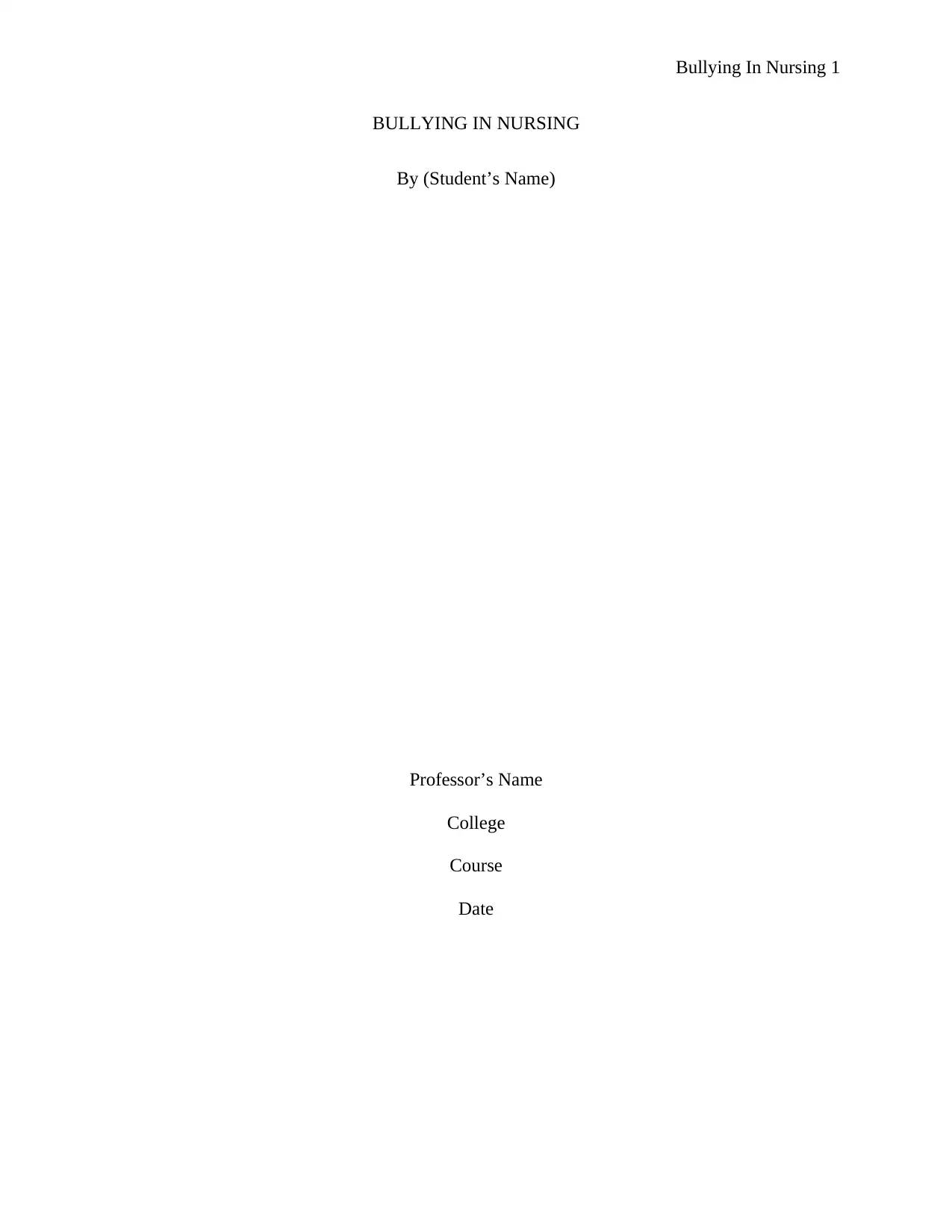
Bullying In Nursing 1
BULLYING IN NURSING
By (Student’s Name)
Professor’s Name
College
Course
Date
BULLYING IN NURSING
By (Student’s Name)
Professor’s Name
College
Course
Date
Paraphrase This Document
Need a fresh take? Get an instant paraphrase of this document with our AI Paraphraser
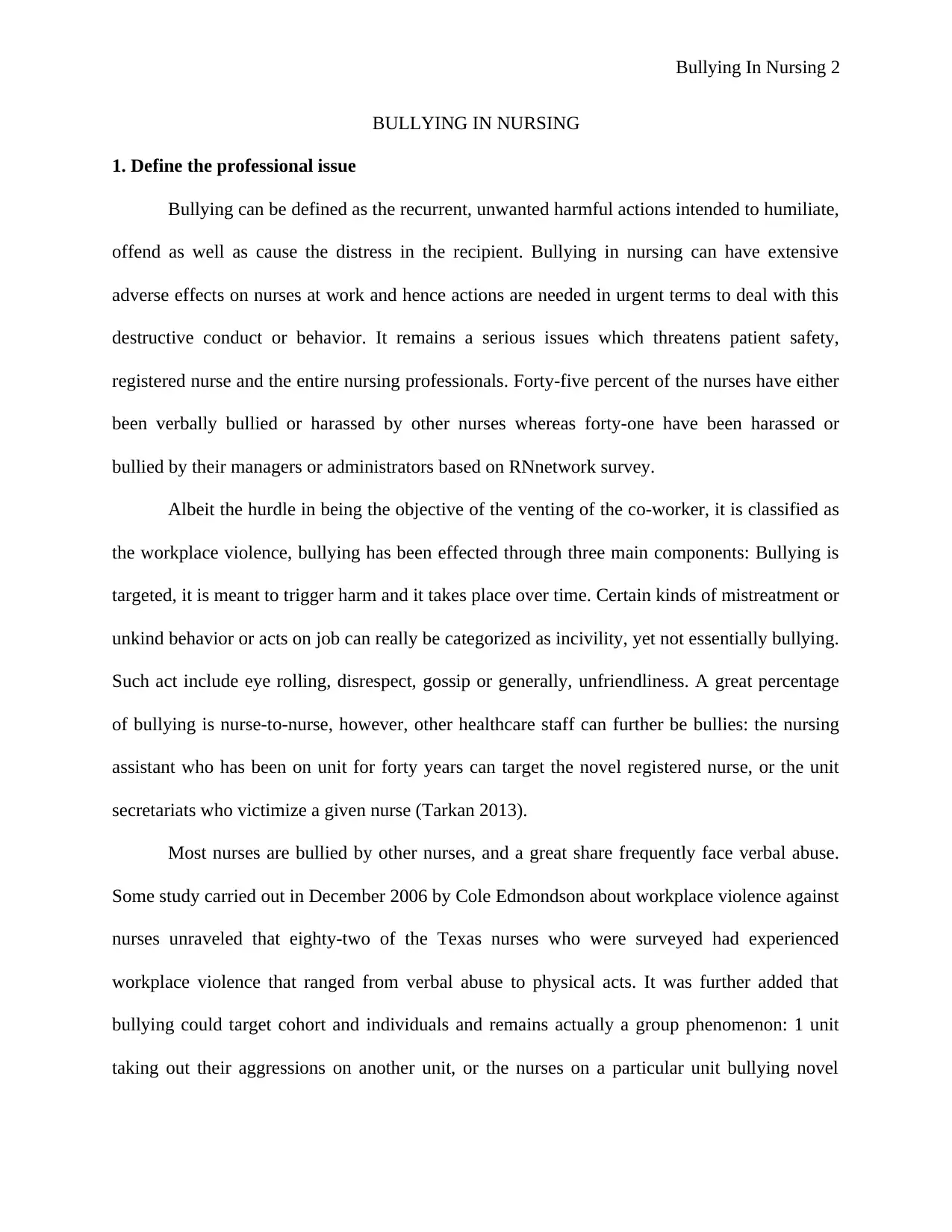
Bullying In Nursing 2
BULLYING IN NURSING
1. Define the professional issue
Bullying can be defined as the recurrent, unwanted harmful actions intended to humiliate,
offend as well as cause the distress in the recipient. Bullying in nursing can have extensive
adverse effects on nurses at work and hence actions are needed in urgent terms to deal with this
destructive conduct or behavior. It remains a serious issues which threatens patient safety,
registered nurse and the entire nursing professionals. Forty-five percent of the nurses have either
been verbally bullied or harassed by other nurses whereas forty-one have been harassed or
bullied by their managers or administrators based on RNnetwork survey.
Albeit the hurdle in being the objective of the venting of the co-worker, it is classified as
the workplace violence, bullying has been effected through three main components: Bullying is
targeted, it is meant to trigger harm and it takes place over time. Certain kinds of mistreatment or
unkind behavior or acts on job can really be categorized as incivility, yet not essentially bullying.
Such act include eye rolling, disrespect, gossip or generally, unfriendliness. A great percentage
of bullying is nurse-to-nurse, however, other healthcare staff can further be bullies: the nursing
assistant who has been on unit for forty years can target the novel registered nurse, or the unit
secretariats who victimize a given nurse (Tarkan 2013).
Most nurses are bullied by other nurses, and a great share frequently face verbal abuse.
Some study carried out in December 2006 by Cole Edmondson about workplace violence against
nurses unraveled that eighty-two of the Texas nurses who were surveyed had experienced
workplace violence that ranged from verbal abuse to physical acts. It was further added that
bullying could target cohort and individuals and remains actually a group phenomenon: 1 unit
taking out their aggressions on another unit, or the nurses on a particular unit bullying novel
BULLYING IN NURSING
1. Define the professional issue
Bullying can be defined as the recurrent, unwanted harmful actions intended to humiliate,
offend as well as cause the distress in the recipient. Bullying in nursing can have extensive
adverse effects on nurses at work and hence actions are needed in urgent terms to deal with this
destructive conduct or behavior. It remains a serious issues which threatens patient safety,
registered nurse and the entire nursing professionals. Forty-five percent of the nurses have either
been verbally bullied or harassed by other nurses whereas forty-one have been harassed or
bullied by their managers or administrators based on RNnetwork survey.
Albeit the hurdle in being the objective of the venting of the co-worker, it is classified as
the workplace violence, bullying has been effected through three main components: Bullying is
targeted, it is meant to trigger harm and it takes place over time. Certain kinds of mistreatment or
unkind behavior or acts on job can really be categorized as incivility, yet not essentially bullying.
Such act include eye rolling, disrespect, gossip or generally, unfriendliness. A great percentage
of bullying is nurse-to-nurse, however, other healthcare staff can further be bullies: the nursing
assistant who has been on unit for forty years can target the novel registered nurse, or the unit
secretariats who victimize a given nurse (Tarkan 2013).
Most nurses are bullied by other nurses, and a great share frequently face verbal abuse.
Some study carried out in December 2006 by Cole Edmondson about workplace violence against
nurses unraveled that eighty-two of the Texas nurses who were surveyed had experienced
workplace violence that ranged from verbal abuse to physical acts. It was further added that
bullying could target cohort and individuals and remains actually a group phenomenon: 1 unit
taking out their aggressions on another unit, or the nurses on a particular unit bullying novel
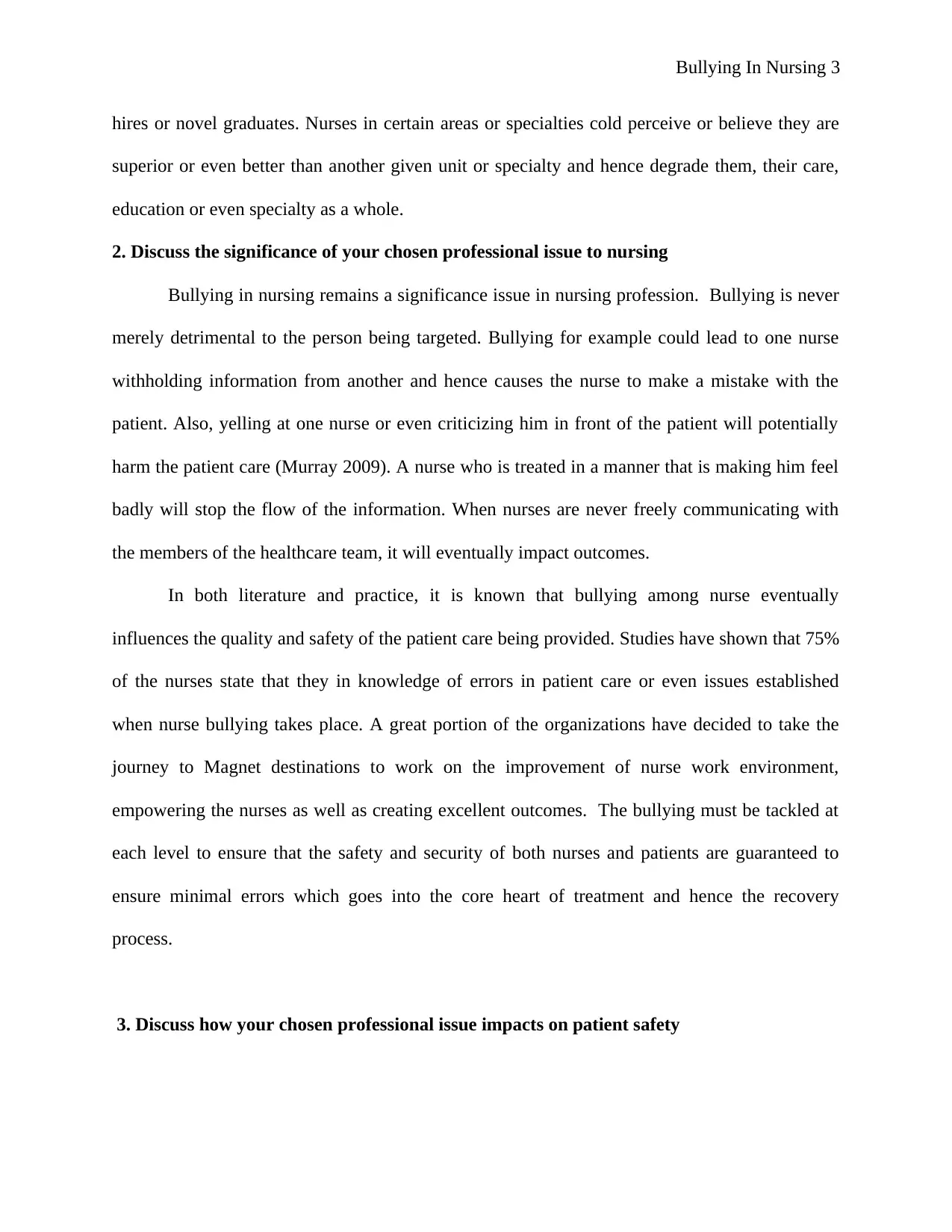
Bullying In Nursing 3
hires or novel graduates. Nurses in certain areas or specialties cold perceive or believe they are
superior or even better than another given unit or specialty and hence degrade them, their care,
education or even specialty as a whole.
2. Discuss the significance of your chosen professional issue to nursing
Bullying in nursing remains a significance issue in nursing profession. Bullying is never
merely detrimental to the person being targeted. Bullying for example could lead to one nurse
withholding information from another and hence causes the nurse to make a mistake with the
patient. Also, yelling at one nurse or even criticizing him in front of the patient will potentially
harm the patient care (Murray 2009). A nurse who is treated in a manner that is making him feel
badly will stop the flow of the information. When nurses are never freely communicating with
the members of the healthcare team, it will eventually impact outcomes.
In both literature and practice, it is known that bullying among nurse eventually
influences the quality and safety of the patient care being provided. Studies have shown that 75%
of the nurses state that they in knowledge of errors in patient care or even issues established
when nurse bullying takes place. A great portion of the organizations have decided to take the
journey to Magnet destinations to work on the improvement of nurse work environment,
empowering the nurses as well as creating excellent outcomes. The bullying must be tackled at
each level to ensure that the safety and security of both nurses and patients are guaranteed to
ensure minimal errors which goes into the core heart of treatment and hence the recovery
process.
3. Discuss how your chosen professional issue impacts on patient safety
hires or novel graduates. Nurses in certain areas or specialties cold perceive or believe they are
superior or even better than another given unit or specialty and hence degrade them, their care,
education or even specialty as a whole.
2. Discuss the significance of your chosen professional issue to nursing
Bullying in nursing remains a significance issue in nursing profession. Bullying is never
merely detrimental to the person being targeted. Bullying for example could lead to one nurse
withholding information from another and hence causes the nurse to make a mistake with the
patient. Also, yelling at one nurse or even criticizing him in front of the patient will potentially
harm the patient care (Murray 2009). A nurse who is treated in a manner that is making him feel
badly will stop the flow of the information. When nurses are never freely communicating with
the members of the healthcare team, it will eventually impact outcomes.
In both literature and practice, it is known that bullying among nurse eventually
influences the quality and safety of the patient care being provided. Studies have shown that 75%
of the nurses state that they in knowledge of errors in patient care or even issues established
when nurse bullying takes place. A great portion of the organizations have decided to take the
journey to Magnet destinations to work on the improvement of nurse work environment,
empowering the nurses as well as creating excellent outcomes. The bullying must be tackled at
each level to ensure that the safety and security of both nurses and patients are guaranteed to
ensure minimal errors which goes into the core heart of treatment and hence the recovery
process.
3. Discuss how your chosen professional issue impacts on patient safety
⊘ This is a preview!⊘
Do you want full access?
Subscribe today to unlock all pages.

Trusted by 1+ million students worldwide
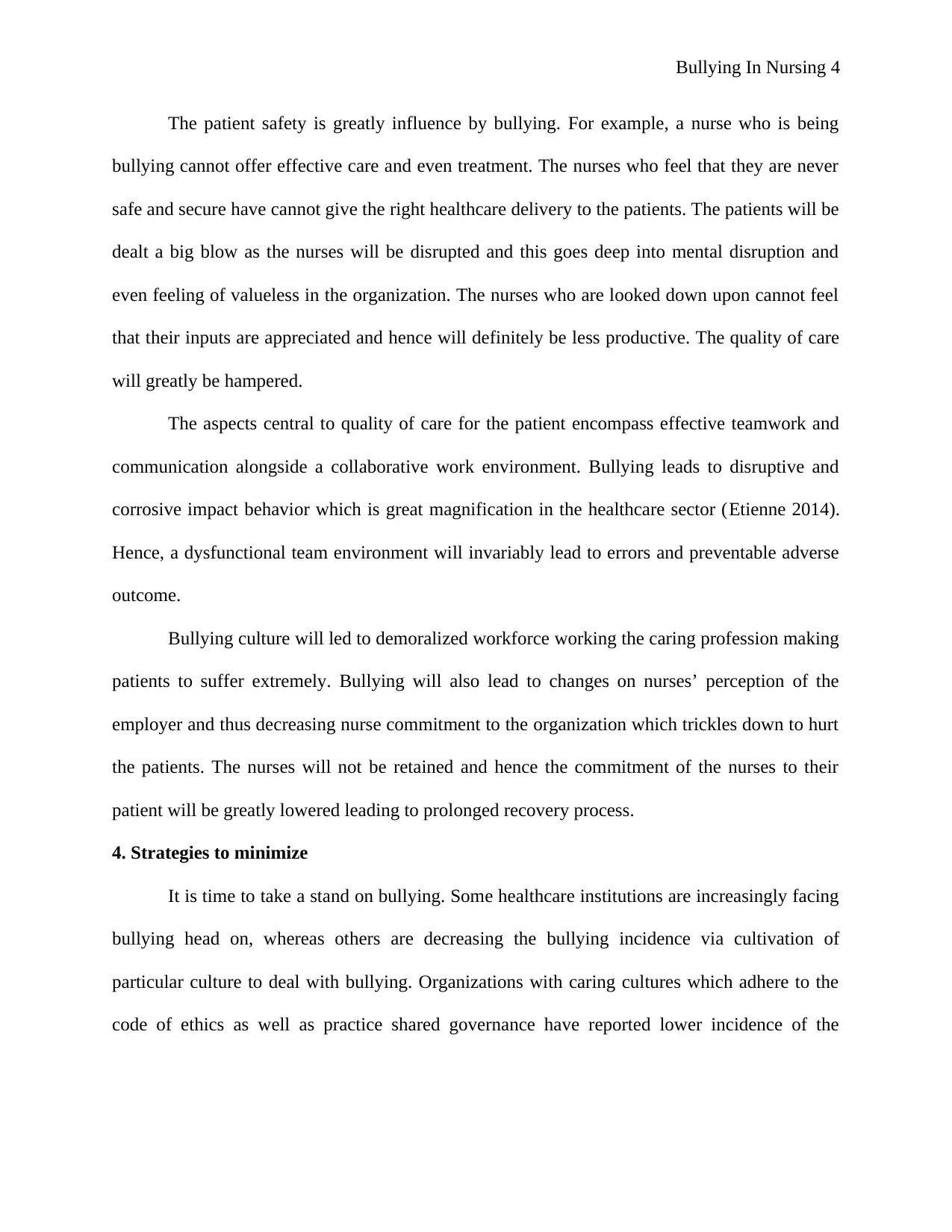
Bullying In Nursing 4
The patient safety is greatly influence by bullying. For example, a nurse who is being
bullying cannot offer effective care and even treatment. The nurses who feel that they are never
safe and secure have cannot give the right healthcare delivery to the patients. The patients will be
dealt a big blow as the nurses will be disrupted and this goes deep into mental disruption and
even feeling of valueless in the organization. The nurses who are looked down upon cannot feel
that their inputs are appreciated and hence will definitely be less productive. The quality of care
will greatly be hampered.
The aspects central to quality of care for the patient encompass effective teamwork and
communication alongside a collaborative work environment. Bullying leads to disruptive and
corrosive impact behavior which is great magnification in the healthcare sector (Etienne 2014).
Hence, a dysfunctional team environment will invariably lead to errors and preventable adverse
outcome.
Bullying culture will led to demoralized workforce working the caring profession making
patients to suffer extremely. Bullying will also lead to changes on nurses’ perception of the
employer and thus decreasing nurse commitment to the organization which trickles down to hurt
the patients. The nurses will not be retained and hence the commitment of the nurses to their
patient will be greatly lowered leading to prolonged recovery process.
4. Strategies to minimize
It is time to take a stand on bullying. Some healthcare institutions are increasingly facing
bullying head on, whereas others are decreasing the bullying incidence via cultivation of
particular culture to deal with bullying. Organizations with caring cultures which adhere to the
code of ethics as well as practice shared governance have reported lower incidence of the
The patient safety is greatly influence by bullying. For example, a nurse who is being
bullying cannot offer effective care and even treatment. The nurses who feel that they are never
safe and secure have cannot give the right healthcare delivery to the patients. The patients will be
dealt a big blow as the nurses will be disrupted and this goes deep into mental disruption and
even feeling of valueless in the organization. The nurses who are looked down upon cannot feel
that their inputs are appreciated and hence will definitely be less productive. The quality of care
will greatly be hampered.
The aspects central to quality of care for the patient encompass effective teamwork and
communication alongside a collaborative work environment. Bullying leads to disruptive and
corrosive impact behavior which is great magnification in the healthcare sector (Etienne 2014).
Hence, a dysfunctional team environment will invariably lead to errors and preventable adverse
outcome.
Bullying culture will led to demoralized workforce working the caring profession making
patients to suffer extremely. Bullying will also lead to changes on nurses’ perception of the
employer and thus decreasing nurse commitment to the organization which trickles down to hurt
the patients. The nurses will not be retained and hence the commitment of the nurses to their
patient will be greatly lowered leading to prolonged recovery process.
4. Strategies to minimize
It is time to take a stand on bullying. Some healthcare institutions are increasingly facing
bullying head on, whereas others are decreasing the bullying incidence via cultivation of
particular culture to deal with bullying. Organizations with caring cultures which adhere to the
code of ethics as well as practice shared governance have reported lower incidence of the
Paraphrase This Document
Need a fresh take? Get an instant paraphrase of this document with our AI Paraphraser
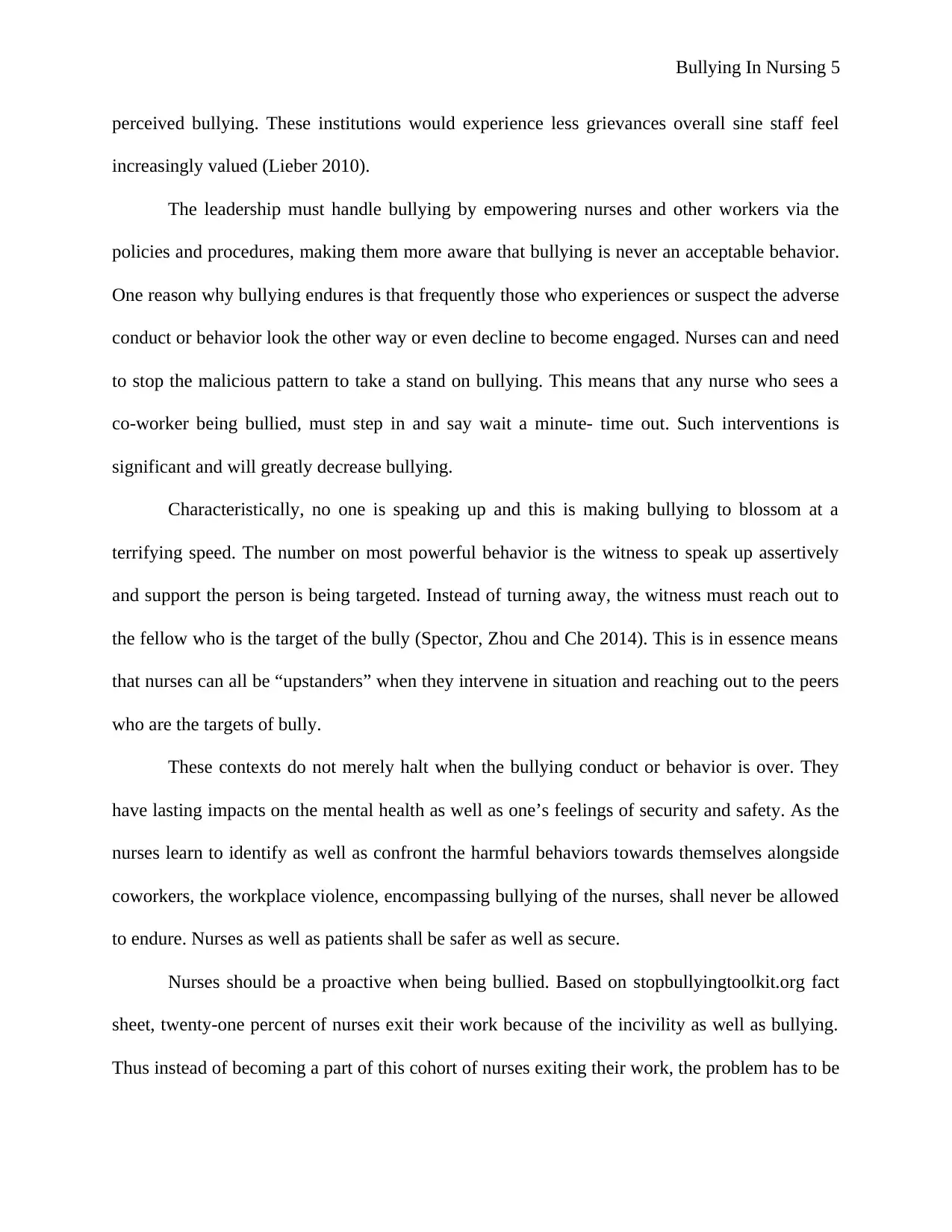
Bullying In Nursing 5
perceived bullying. These institutions would experience less grievances overall sine staff feel
increasingly valued (Lieber 2010).
The leadership must handle bullying by empowering nurses and other workers via the
policies and procedures, making them more aware that bullying is never an acceptable behavior.
One reason why bullying endures is that frequently those who experiences or suspect the adverse
conduct or behavior look the other way or even decline to become engaged. Nurses can and need
to stop the malicious pattern to take a stand on bullying. This means that any nurse who sees a
co-worker being bullied, must step in and say wait a minute- time out. Such interventions is
significant and will greatly decrease bullying.
Characteristically, no one is speaking up and this is making bullying to blossom at a
terrifying speed. The number on most powerful behavior is the witness to speak up assertively
and support the person is being targeted. Instead of turning away, the witness must reach out to
the fellow who is the target of the bully (Spector, Zhou and Che 2014). This is in essence means
that nurses can all be “upstanders” when they intervene in situation and reaching out to the peers
who are the targets of bully.
These contexts do not merely halt when the bullying conduct or behavior is over. They
have lasting impacts on the mental health as well as one’s feelings of security and safety. As the
nurses learn to identify as well as confront the harmful behaviors towards themselves alongside
coworkers, the workplace violence, encompassing bullying of the nurses, shall never be allowed
to endure. Nurses as well as patients shall be safer as well as secure.
Nurses should be a proactive when being bullied. Based on stopbullyingtoolkit.org fact
sheet, twenty-one percent of nurses exit their work because of the incivility as well as bullying.
Thus instead of becoming a part of this cohort of nurses exiting their work, the problem has to be
perceived bullying. These institutions would experience less grievances overall sine staff feel
increasingly valued (Lieber 2010).
The leadership must handle bullying by empowering nurses and other workers via the
policies and procedures, making them more aware that bullying is never an acceptable behavior.
One reason why bullying endures is that frequently those who experiences or suspect the adverse
conduct or behavior look the other way or even decline to become engaged. Nurses can and need
to stop the malicious pattern to take a stand on bullying. This means that any nurse who sees a
co-worker being bullied, must step in and say wait a minute- time out. Such interventions is
significant and will greatly decrease bullying.
Characteristically, no one is speaking up and this is making bullying to blossom at a
terrifying speed. The number on most powerful behavior is the witness to speak up assertively
and support the person is being targeted. Instead of turning away, the witness must reach out to
the fellow who is the target of the bully (Spector, Zhou and Che 2014). This is in essence means
that nurses can all be “upstanders” when they intervene in situation and reaching out to the peers
who are the targets of bully.
These contexts do not merely halt when the bullying conduct or behavior is over. They
have lasting impacts on the mental health as well as one’s feelings of security and safety. As the
nurses learn to identify as well as confront the harmful behaviors towards themselves alongside
coworkers, the workplace violence, encompassing bullying of the nurses, shall never be allowed
to endure. Nurses as well as patients shall be safer as well as secure.
Nurses should be a proactive when being bullied. Based on stopbullyingtoolkit.org fact
sheet, twenty-one percent of nurses exit their work because of the incivility as well as bullying.
Thus instead of becoming a part of this cohort of nurses exiting their work, the problem has to be
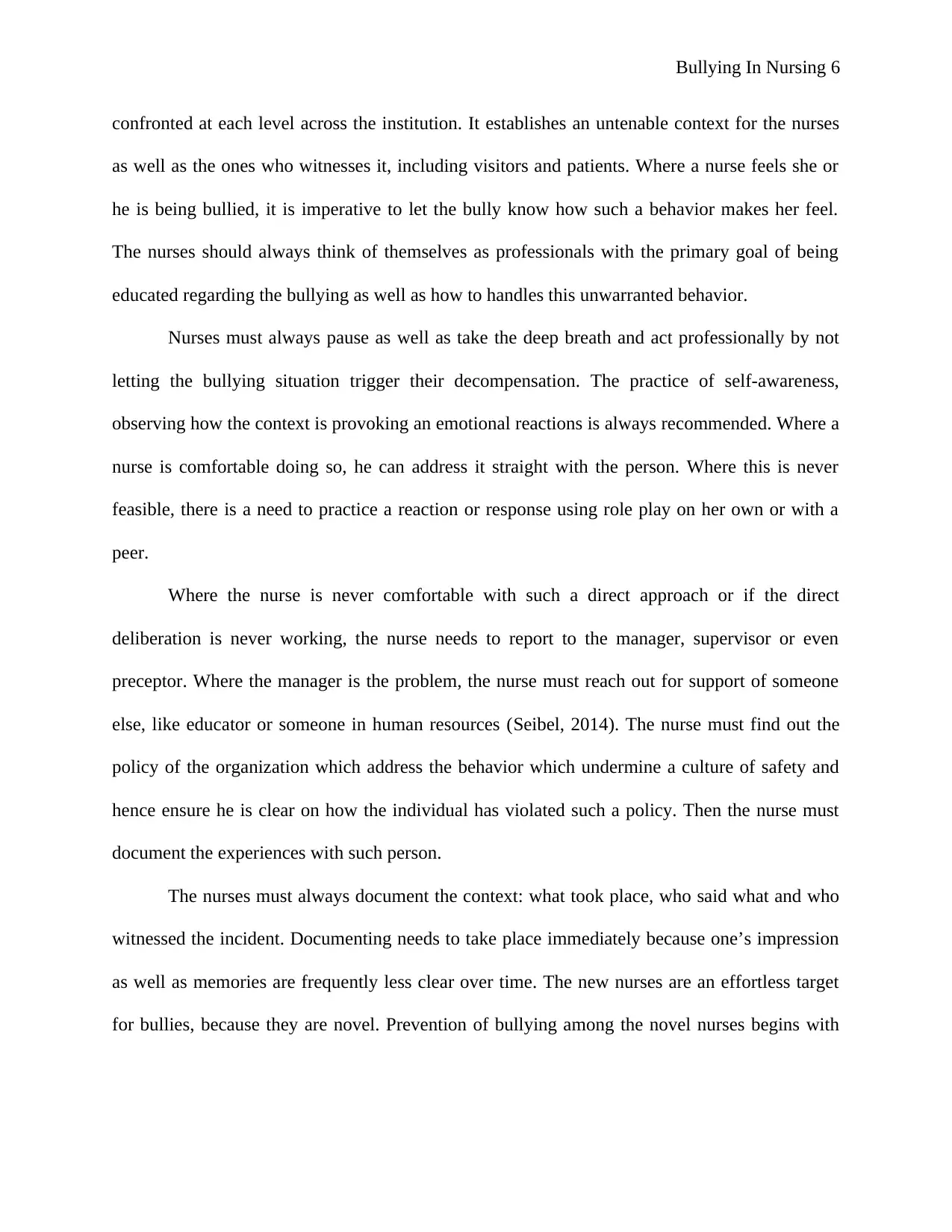
Bullying In Nursing 6
confronted at each level across the institution. It establishes an untenable context for the nurses
as well as the ones who witnesses it, including visitors and patients. Where a nurse feels she or
he is being bullied, it is imperative to let the bully know how such a behavior makes her feel.
The nurses should always think of themselves as professionals with the primary goal of being
educated regarding the bullying as well as how to handles this unwarranted behavior.
Nurses must always pause as well as take the deep breath and act professionally by not
letting the bullying situation trigger their decompensation. The practice of self-awareness,
observing how the context is provoking an emotional reactions is always recommended. Where a
nurse is comfortable doing so, he can address it straight with the person. Where this is never
feasible, there is a need to practice a reaction or response using role play on her own or with a
peer.
Where the nurse is never comfortable with such a direct approach or if the direct
deliberation is never working, the nurse needs to report to the manager, supervisor or even
preceptor. Where the manager is the problem, the nurse must reach out for support of someone
else, like educator or someone in human resources (Seibel, 2014). The nurse must find out the
policy of the organization which address the behavior which undermine a culture of safety and
hence ensure he is clear on how the individual has violated such a policy. Then the nurse must
document the experiences with such person.
The nurses must always document the context: what took place, who said what and who
witnessed the incident. Documenting needs to take place immediately because one’s impression
as well as memories are frequently less clear over time. The new nurses are an effortless target
for bullies, because they are novel. Prevention of bullying among the novel nurses begins with
confronted at each level across the institution. It establishes an untenable context for the nurses
as well as the ones who witnesses it, including visitors and patients. Where a nurse feels she or
he is being bullied, it is imperative to let the bully know how such a behavior makes her feel.
The nurses should always think of themselves as professionals with the primary goal of being
educated regarding the bullying as well as how to handles this unwarranted behavior.
Nurses must always pause as well as take the deep breath and act professionally by not
letting the bullying situation trigger their decompensation. The practice of self-awareness,
observing how the context is provoking an emotional reactions is always recommended. Where a
nurse is comfortable doing so, he can address it straight with the person. Where this is never
feasible, there is a need to practice a reaction or response using role play on her own or with a
peer.
Where the nurse is never comfortable with such a direct approach or if the direct
deliberation is never working, the nurse needs to report to the manager, supervisor or even
preceptor. Where the manager is the problem, the nurse must reach out for support of someone
else, like educator or someone in human resources (Seibel, 2014). The nurse must find out the
policy of the organization which address the behavior which undermine a culture of safety and
hence ensure he is clear on how the individual has violated such a policy. Then the nurse must
document the experiences with such person.
The nurses must always document the context: what took place, who said what and who
witnessed the incident. Documenting needs to take place immediately because one’s impression
as well as memories are frequently less clear over time. The new nurses are an effortless target
for bullies, because they are novel. Prevention of bullying among the novel nurses begins with
⊘ This is a preview!⊘
Do you want full access?
Subscribe today to unlock all pages.

Trusted by 1+ million students worldwide
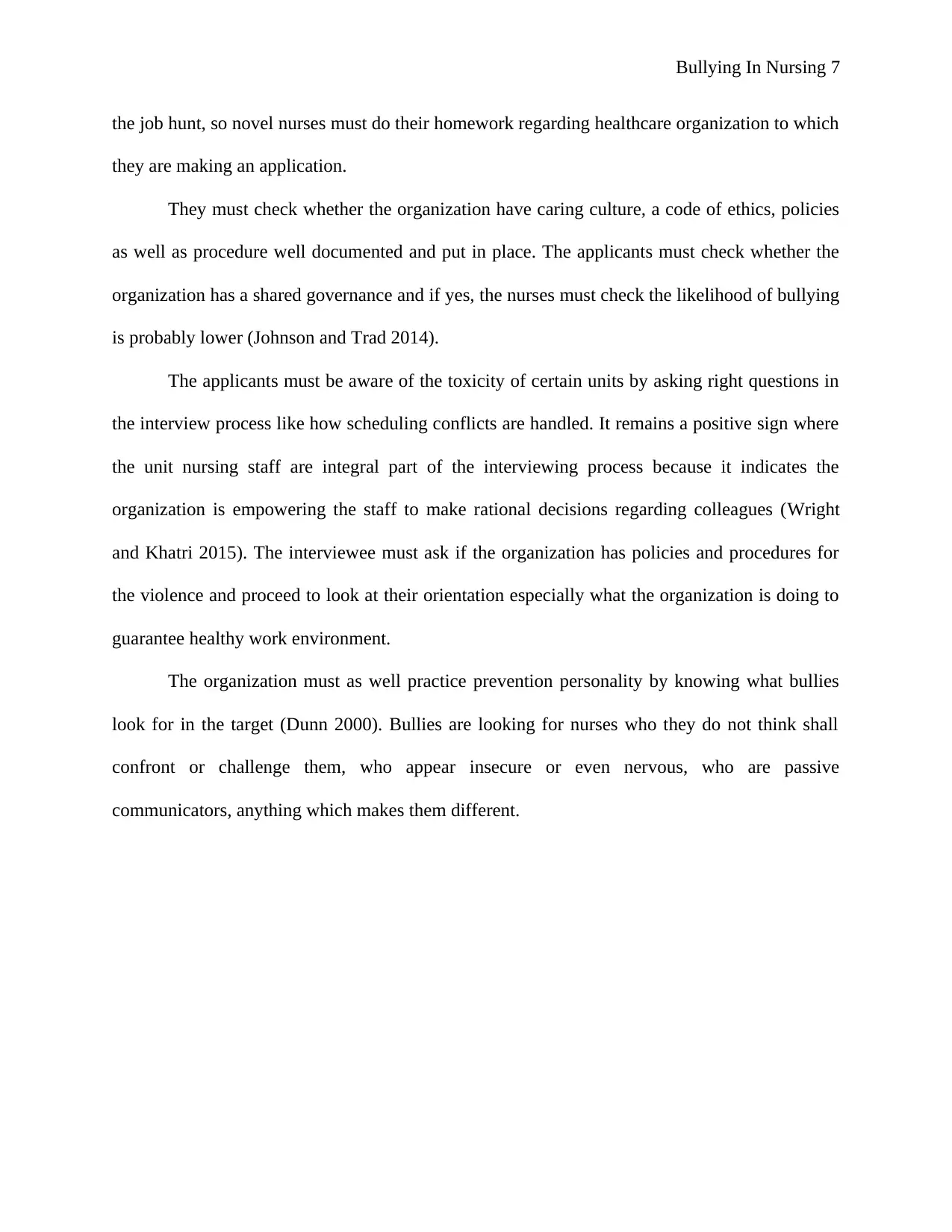
Bullying In Nursing 7
the job hunt, so novel nurses must do their homework regarding healthcare organization to which
they are making an application.
They must check whether the organization have caring culture, a code of ethics, policies
as well as procedure well documented and put in place. The applicants must check whether the
organization has a shared governance and if yes, the nurses must check the likelihood of bullying
is probably lower (Johnson and Trad 2014).
The applicants must be aware of the toxicity of certain units by asking right questions in
the interview process like how scheduling conflicts are handled. It remains a positive sign where
the unit nursing staff are integral part of the interviewing process because it indicates the
organization is empowering the staff to make rational decisions regarding colleagues (Wright
and Khatri 2015). The interviewee must ask if the organization has policies and procedures for
the violence and proceed to look at their orientation especially what the organization is doing to
guarantee healthy work environment.
The organization must as well practice prevention personality by knowing what bullies
look for in the target (Dunn 2000). Bullies are looking for nurses who they do not think shall
confront or challenge them, who appear insecure or even nervous, who are passive
communicators, anything which makes them different.
the job hunt, so novel nurses must do their homework regarding healthcare organization to which
they are making an application.
They must check whether the organization have caring culture, a code of ethics, policies
as well as procedure well documented and put in place. The applicants must check whether the
organization has a shared governance and if yes, the nurses must check the likelihood of bullying
is probably lower (Johnson and Trad 2014).
The applicants must be aware of the toxicity of certain units by asking right questions in
the interview process like how scheduling conflicts are handled. It remains a positive sign where
the unit nursing staff are integral part of the interviewing process because it indicates the
organization is empowering the staff to make rational decisions regarding colleagues (Wright
and Khatri 2015). The interviewee must ask if the organization has policies and procedures for
the violence and proceed to look at their orientation especially what the organization is doing to
guarantee healthy work environment.
The organization must as well practice prevention personality by knowing what bullies
look for in the target (Dunn 2000). Bullies are looking for nurses who they do not think shall
confront or challenge them, who appear insecure or even nervous, who are passive
communicators, anything which makes them different.
Paraphrase This Document
Need a fresh take? Get an instant paraphrase of this document with our AI Paraphraser
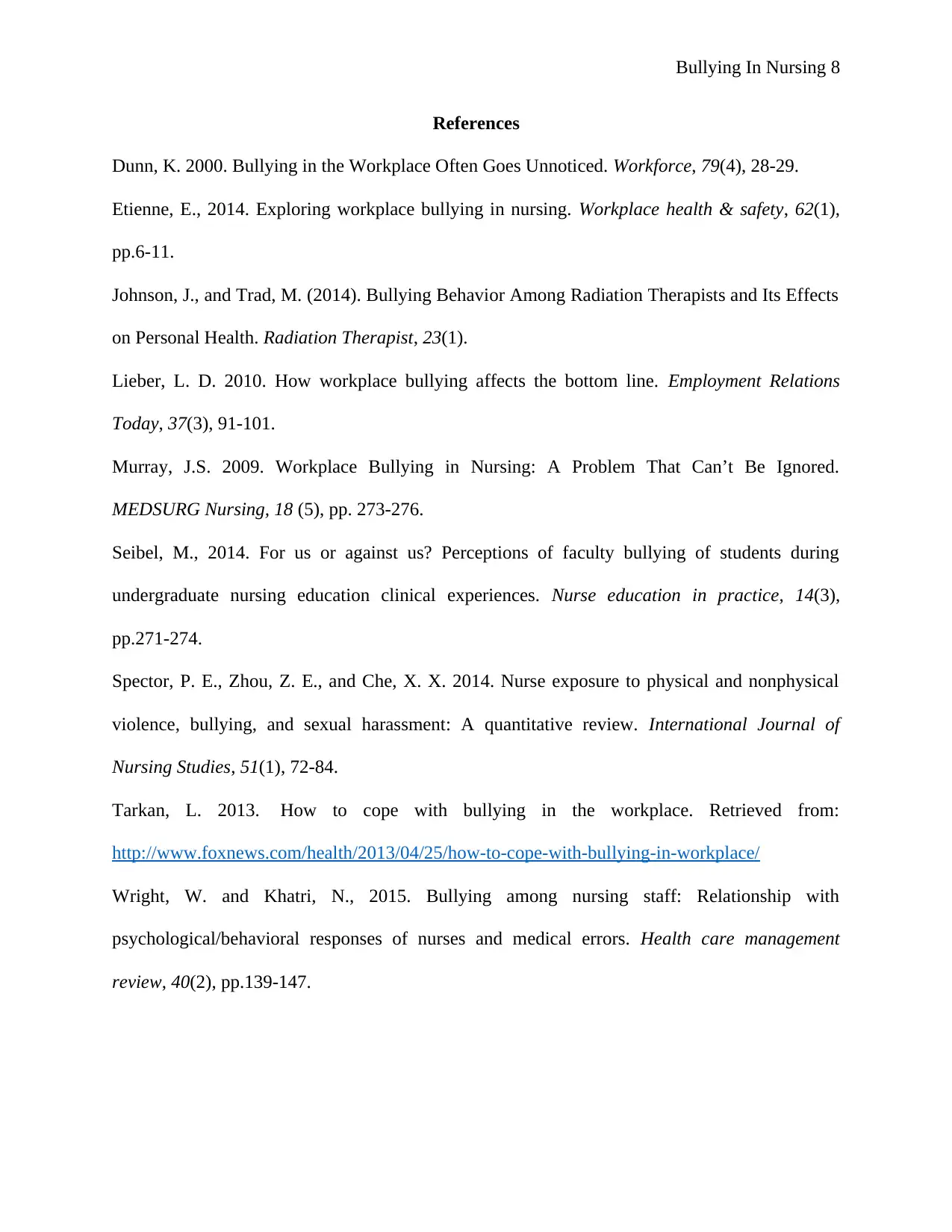
Bullying In Nursing 8
References
Dunn, K. 2000. Bullying in the Workplace Often Goes Unnoticed. Workforce, 79(4), 28-29.
Etienne, E., 2014. Exploring workplace bullying in nursing. Workplace health & safety, 62(1),
pp.6-11.
Johnson, J., and Trad, M. (2014). Bullying Behavior Among Radiation Therapists and Its Effects
on Personal Health. Radiation Therapist, 23(1).
Lieber, L. D. 2010. How workplace bullying affects the bottom line. Employment Relations
Today, 37(3), 91-101.
Murray, J.S. 2009. Workplace Bullying in Nursing: A Problem That Can’t Be Ignored.
MEDSURG Nursing, 18 (5), pp. 273-276.
Seibel, M., 2014. For us or against us? Perceptions of faculty bullying of students during
undergraduate nursing education clinical experiences. Nurse education in practice, 14(3),
pp.271-274.
Spector, P. E., Zhou, Z. E., and Che, X. X. 2014. Nurse exposure to physical and nonphysical
violence, bullying, and sexual harassment: A quantitative review. International Journal of
Nursing Studies, 51(1), 72-84.
Tarkan, L. 2013. How to cope with bullying in the workplace. Retrieved from:
http://www.foxnews.com/health/2013/04/25/how-to-cope-with-bullying-in-workplace/
Wright, W. and Khatri, N., 2015. Bullying among nursing staff: Relationship with
psychological/behavioral responses of nurses and medical errors. Health care management
review, 40(2), pp.139-147.
References
Dunn, K. 2000. Bullying in the Workplace Often Goes Unnoticed. Workforce, 79(4), 28-29.
Etienne, E., 2014. Exploring workplace bullying in nursing. Workplace health & safety, 62(1),
pp.6-11.
Johnson, J., and Trad, M. (2014). Bullying Behavior Among Radiation Therapists and Its Effects
on Personal Health. Radiation Therapist, 23(1).
Lieber, L. D. 2010. How workplace bullying affects the bottom line. Employment Relations
Today, 37(3), 91-101.
Murray, J.S. 2009. Workplace Bullying in Nursing: A Problem That Can’t Be Ignored.
MEDSURG Nursing, 18 (5), pp. 273-276.
Seibel, M., 2014. For us or against us? Perceptions of faculty bullying of students during
undergraduate nursing education clinical experiences. Nurse education in practice, 14(3),
pp.271-274.
Spector, P. E., Zhou, Z. E., and Che, X. X. 2014. Nurse exposure to physical and nonphysical
violence, bullying, and sexual harassment: A quantitative review. International Journal of
Nursing Studies, 51(1), 72-84.
Tarkan, L. 2013. How to cope with bullying in the workplace. Retrieved from:
http://www.foxnews.com/health/2013/04/25/how-to-cope-with-bullying-in-workplace/
Wright, W. and Khatri, N., 2015. Bullying among nursing staff: Relationship with
psychological/behavioral responses of nurses and medical errors. Health care management
review, 40(2), pp.139-147.
1 out of 8
Related Documents
Your All-in-One AI-Powered Toolkit for Academic Success.
+13062052269
info@desklib.com
Available 24*7 on WhatsApp / Email
![[object Object]](/_next/static/media/star-bottom.7253800d.svg)
Unlock your academic potential
Copyright © 2020–2025 A2Z Services. All Rights Reserved. Developed and managed by ZUCOL.





